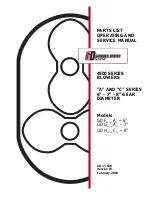
12
05
Installation
Manual 2008 Rev A p/n 2008
AIR FILTER
PRESSURE
RELIEF VALVE
CHECK VALVE
FLEX CONN.
PRESSURE GAUGE
DISCHARGE
SILENCER
INTAKE SILENCER
FLOW
FLOW
Figure 5-1 – Typical Blower Installation
A blower may be driven by direct-coupling to
the driver or by V-belt drive for the purpose of
obtaining other speeds within the approved
range.
See Motor Drives on page 19
for more
information.
Blowers from Tuthill Springfield are internally
and externally treated after factory assembly
and testing to protect against rusting in normal
atmospheric conditions prior to installation.
The maximum period of internal protection
is considered to be 6 months under average
conditions, provided closing plugs and seals are
not removed. Protection against chemical or salt-
water atmosphere is not provided. Avoid opening
the blower until ready to begin installation, as
protection will be quickly lost due to evaporation.
For recommended preparations for long-term
storage (longer than 6 months),
see Long-Term
Storage on page 30
.
Location
Install the blower in a room or outdoor area that
supplies adequate space and lighting for routine
maintenance. Make sure that indoor installation
areas are well ventilated and kept as cool as
possible, because operating the blower at elevated
temperatures can result in nuisance overload or
temperature shutdowns. An unprotected outdoor
installation is satisfactory only when correct
lubrication for the expected temperatures is
provided.
See Recommended Lubricants on
page 41
.
Foundation
Your blower does not need a special foundation;
however, it does require a solid, level floor and
adequate frame support. Bolt the blower system to
the floor and seal any cracks.
Blower Air Intake
To minimize maintenance, supply the blower with
the cleanest air possible. The air must not contain
any flammable or toxic gases, as the blower will
concentrate these gases. This could result in
damage to the blower and surrounding property
and lead to personal injury or death. Do not block
or restrict the opening of the blower, as the motor
could overheat and fail.
Do not use blowers on explosive or hazardous
gases. Do not exceed the limits described in
Table 4-2 on page 8
on performance criteria
such as pressure differential, running speed, and
discharge temperature.
If it is necessary to take air from a remote source,
such as in a vacuum application, make sure the
diameter of the piping is at least equal to the
diameter of the blower inlet. For distances greater
than 20 ft (6 m), enlarge the pipe diameter to
reduce inlet restriction. Excessive restriction will
reduce the efficiency of the blower and elevate its
discharge temperature. The piping used should
also be corrosion-resistant and free of scale and
dirt. Keep the inlet covered to keep out foreign
objects and rain. Vacuum kits are available.
Summary of Contents for PD Plus 9000 Series
Page 65: ......
















































